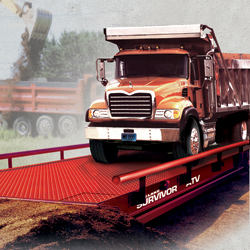When it comes to weighing commercial vehicles, there are two main options: static truck scales and weigh in motion scales. Both types of scales serve the same basic purpose. To accurately measure the weight of a vehicle, but they differ in terms of how they are used and their specific capabilities.
Traditional “Static” Truck Weighing
Static truck scales are the more traditional option. These truck scales consists of a weigh bridge that’s usually around 70 feet long, that’s usually above ground and installed on a concrete foundation. The vehicle drives on to the scale to be weighed. Static truck scales are typically found everywhere from feed mails to recycling centers to weigh stations. They are used to weigh vehicles that are fully stopped.
Static Weighing Advantages
One advantage of static truck scales is that they are accurate because the vehicle is fully stopped and stationary when it is weighed, the accuracy is better than a weigh in motion scale in which the vehicle never stops. Additionally, static scales are common. They’ve been utilized for many years. Technicians know how they work and spare scale parts are readily available, and the vast majority are legal for trade.

Disadvantages of Static Weighing
However, there are also some disadvantages to using static truck scales because the vehicle must come to a complete stop to be weighed. These scales can cause delays and disrupt traffic flow. Additionally, a static scale takes up a lot of room. The scale weigh bridge is usually at least 70 feet long and requires plenty of room for the truck to enter and exit. You also have to pour a large concrete foundation for the static scale to be placed on. Therefore, static scales are typically more expensive than weigh in motion systems.
Weighing a Vehicle While It’s Still Moving
Weigh in motion scales on the other hand are designed to weigh vehicles while they are in motion. These scales use sensors to accurately measure the weight of a moving vehicle, without the need for it to come to a complete stop.
Weigh In Motion Advantages
One advantage of weigh in motion scales is that they allow for the weighing of vehicles without disrupting traffic flow. Because the vehicle does not need to come to a complete stop. weigh in motion scales can help to reduce delays and improve overall efficiency. Additionally, weigh in motion scales can be installed in a smaller area since the scale platform itself is only a fraction of the size of a traditional truck scale.
Negatives about Weigh In Motion
However, there are some drawbacks to using weigh in motion scales. One potential issue is accuracy because the vehicle is in motion when weighing, there’s a greater potential for error compared to static scales. Additionally, weigh in motion scales may be more complex. For example, if a load cell were to fail, the entire scale platform would likely need to be lifted in order to change the cell. And finally, at the time of this article, there are very few legal for trade options when it comes to weighing trucks in motion.
So which type of scale is the best option for you?
Ultimately, the decision will depend your specific needs and circumstances. If you need the most accurate weigh possible, static scales may still be the best way to go. However, if you need to weigh vehicles quickly and you’re willing to sacrifice a little accuracy, then a weigh in motion system may be the better choice.
If you need some assistance choosing your next vehicle scale, be sure to contact us via phone by calling (919) 776-7737 or by filling out the RFQ form on our website. We sell and service many of the top brands of truck scales on the market today including B-Tek, Cardinal, CMI, Mid America, Rice Lake, Thurman, & Weigh-Tronix.